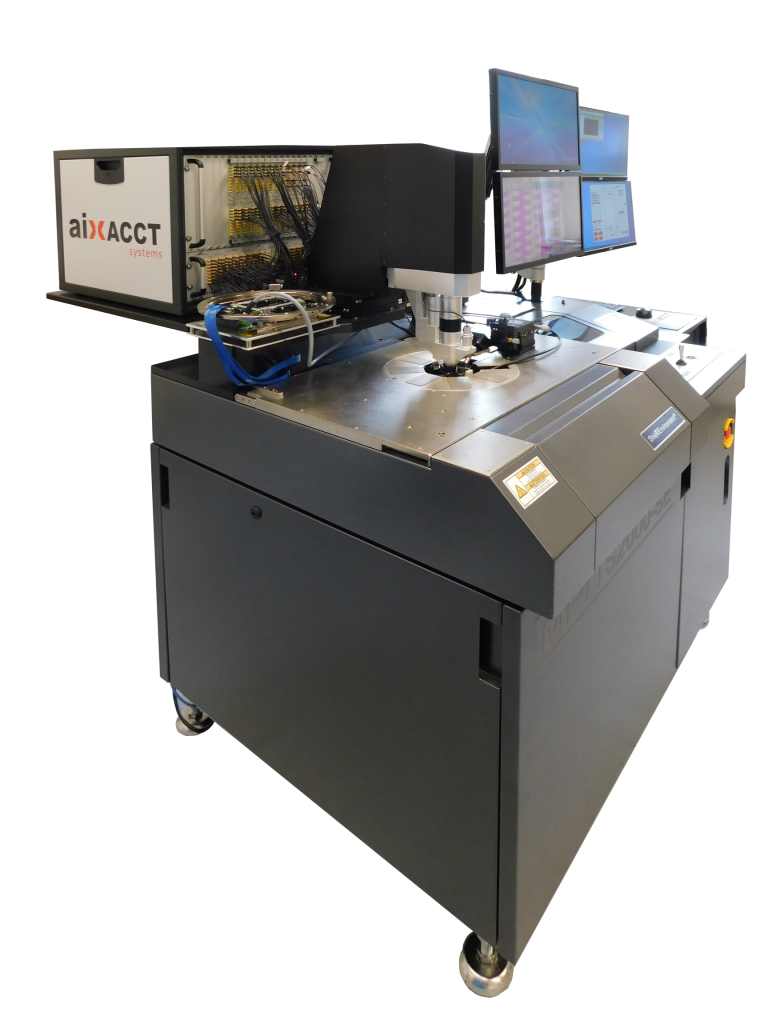Get detailed curves fast
The trend towards neuromorphic computer and memory development calls for new and complex testing systems. This is where aixMATRIX comes in. It is specially tailored to the needs of memristive memory architectures. The fully integrated matrix test system enables simultaneous excitation of test structures on 64 analogue channels with 16-bit DA converters, each with a sample rate of 100 MS/sec. The bipolar signals can be generated with up to ±10 V. An ultra-fast and bipolar adjustable current compliance enables detailed analysis of memristive memories with response times ranging to below 50 ns.
Ideal for research and development
The current responses of the test structures can be resolved on 32 channels (16 bit, 200 MS/sec). This allows users to investigate both active and passive memory arrays measuring up to 32 x 32 cells simultaneously. Integration on a 200 mm wafer prober enables fast testing of complex architectures at wafer level. The 32 x 32 matrix test system is therefore the ideal platform for research and development in new neuromorphic memory systems.
-

Complete system for memristive arrays
- Semi-automatic wafer prober
- Innovative contacting, incl. adjustable current amplification and analogue adjustable current compliance
- Matrix system with 64 DACs and 32 ADCs
- LabView-based software environment with optional Matlab interface
- TF-Analyzer 3000 with FE and RS module
Highly versatile
The parallel test system is built around a semi-automatic wafer prober. Thanks to automatic contacting, this makes it possible to step through an entire wafer with software support. As a result, aixMATRIX is ideal for production tests and experiments with large statistics.
Highlights include:
- Fully shielded measurement environment
- Thermochuck (measurements from -60 °C to 300 °C possible depending on version)
- Manual front loading or convenient side loading of wafers
- Also compatible with individual dies instead of entire wafers
For measuring individual memristors, we have developed a wedge contacting system that allows you to measure in the lower nanosecond range. For measurements on more complex structures or arrays, simply switch to matrix mode.
-
Supplied by a gigasample measuring card (DAC + ADC), you can characterize the kinetics of your individual memristors quickly and easily in wedge mode. The specially developed current compliance reacts within 50 ns and is implemented directly on the wedge to be as close as possible to the tested cells. This also amplifies the measured current signal, which is directed to the measuring card.
Combined with the semi-automatic wafer prober, you can easily repeat your measurement for every available cell.
-
If you need to measure more complex structures, switch from wedge mode to matrix mode.
64 DAC and 32 ADC channels are available for freely configurable contact point layout. As with wedge mode, you will find 32 fast, independent and analogue programmable current compliances close to the contact, along with 32 adjustable current amplifiers.
FEATURES
64 independent DACs for emitting a unique waveform with 100 MS/s simultaneously at each contact point. 32 independent ADCs. 32 current compliances that allow you to limit the current at the input of your memristor array within 100 ns. 32 current amplifiers that let you record 32 independent current signals with 100 MS/s at the output of your array. 64 independent DACs for emitting a unique waveform with 100 MS/s simultaneously at each contact point.
32 independent ADCs.
32 current compliances that allow you to limit the current at the input of your memristor array within 100 ns.
32 current amplifiers that let you record 32 independent current signals with 100 MS/s at the output of your array.
Thanks to the megazoom microscope and side camera on the wafer prober, the outstanding optics allow you to contact every structure quickly and securely.
